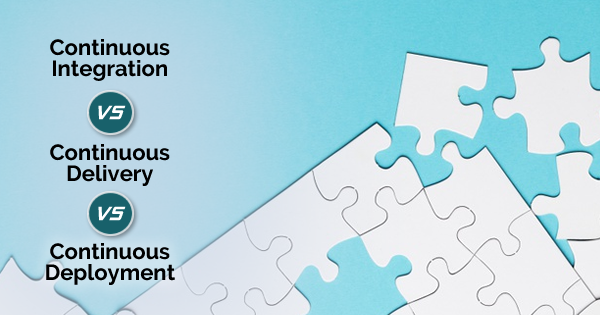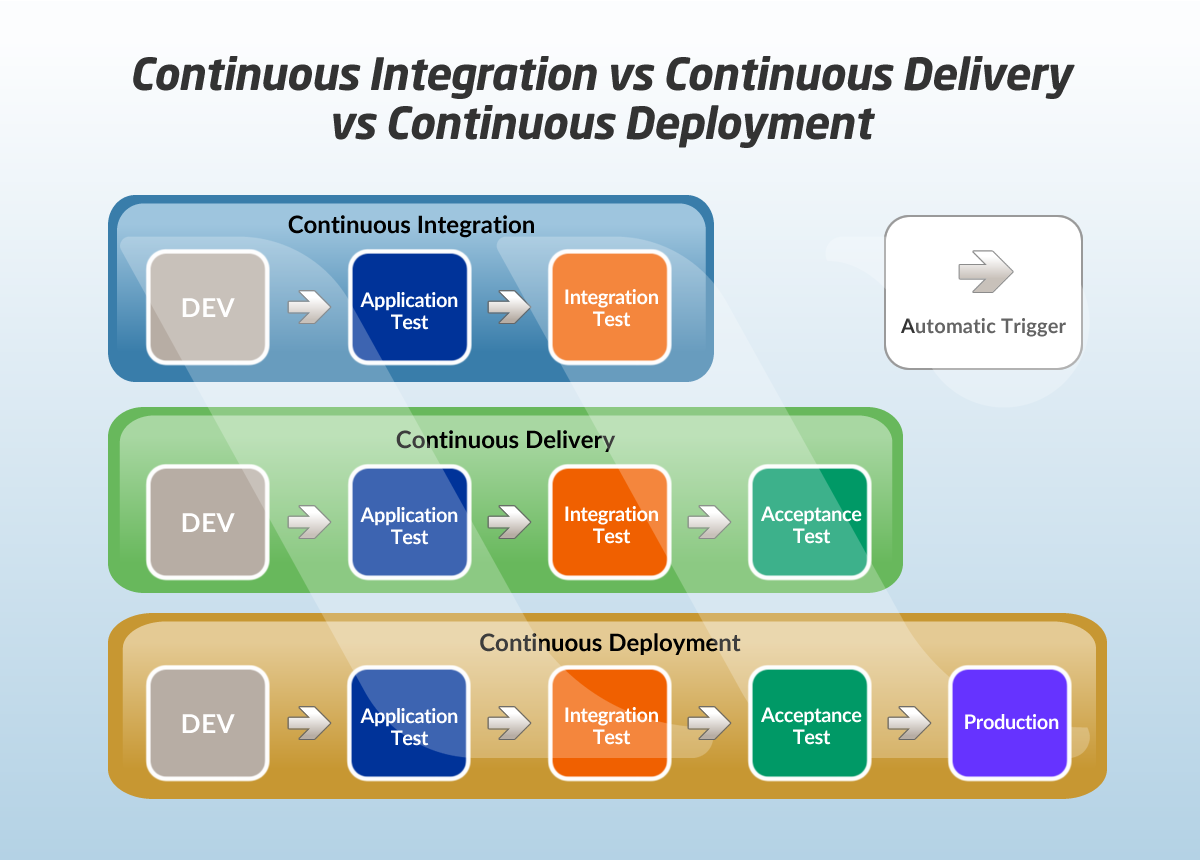Continuous integration vs continuous delivery vs continuous deployment has been the prime topic of discussion among DevOps professionals. To simplify, CI or Continuous Integration is a practice that aims at smoothening the process of releases. Though both continuous deployment and continuous development both are referred to as CD, there is a difference between them both.
Moreover, these differences between Continuous integration vs continuous delivery vs continuous deployment hold a significant impact on the overall business. For a better analysis of the Continuous integration vs continuous delivery vs continuous deployment study, it would be better to learn each of the terms individually.
Preparing to become a certified DevOps professional? Check our DevOps Certifications Training Courses now!
Understanding the Terms: Continuous Integration vs Continuous Delivery vs Continuous Deployment
Before proceeding with this discussion comparing the implications of continuous delivery, continuous integration, and continuous deployment, let us understand the terms first. This section would help you find out the definitions of these terms.
Continuous Integration
Continuous Integration or CI is a development practice. It involves developers integrating code into a shared repository at frequent intervals, generally many times in a day. An automated build and automated tests help in verification of each integration. Generally, CI involves the integration of changes from various developers into the mainline as soon as possible. As a result, developers do not divert away from the main code.
The foremost advantage of CI is the ability for identifying errors quickly and easily. Since CI constantly tracks the changes in the code, developers could find out the change responsible for a concerned problem and solve it quickly. The lack of continuous integration demands manual coordination and communication between developers while contributing code to the final product. CI takes away the communication burden with a non-CI environment thereby preventing unwanted bureaucratic costs to projects. CI technologies come with various opportunities for learning more about hosting infrastructure, orchestration technologies, and version control systems.
Continuous Delivery
Continuous Delivery is also one of the popular contemporary software development practices that involve automatic preparation of code changes for releasing to production. It is a strong pillar of modern application development. It helps in the production of software in short cycles. The primary objective of continuous delivery is to ensure that deployments are reliable, predictable and available on demand.
In simple words, continuous delivery helps in adding changes to production in a safe, faster and sustainable manner. The notable benefits of continuous delivery include faster time to market, lower costs and lower risk releases along with higher quality. These benefits of continuous delivery are possible only through its capability for addressing diverse technological functionalities. For example, continuous delivery helps in automation of the software release process thereby resulting in higher developer productivity. In addition, continuous delivery helps in faster and frequent delivery of updates to customers.
Continuous Deployment
Continuous Deployment (CD) is a software release strategy that aims at improving the visibility of code to users in production. It involves the automatic release of code commits into the production environment that passes the automated testing phase. Continuous deployment is ideal for taking away human protective measures against unverified code in live software. Basically, continuous deployment aims at reduction of lead time i.e. the time between the development of one new line of code and live users using the new code in production.
The foremost benefit of continuous deployment is evident in the faster return on investment for every feature after its development. As a result, you don’t have to worry about large capital investments with the help of continuous deployment. Furthermore, the facility of early feedback from users’ works regarding new features as they find releases in live production is also helpful. Techniques such as parallel testing could help in finding out the feature that works best for users.
DevOps is one of the milestones that has brought paradigm shift in the technology era. Let’s have a quick DevOps introduction to learn the basics.
Continuous Delivery vs Continuous Deployment
To start with continuous delivery of continuous delivery vs continuous deployment analysis, continuous delivery is where the user is ready and is ready to deploy any edition for any platform that supports, at any instance. On the other hand, continuous deployment is the case where users involve in real-time deployment. This is how continuous delivery vs continuous deployment can be summed up.
Through continuous delivery, it is quite a manual procedure when it comes to deploying to production. In short, the continuous delivery process is initiated manually. So, the difference between continuous delivery and continuous deployment here is that delivery differs from deployment that automates straightaway through the test post-deployment.
To conclude, the difference between continuous delivery and continuous deployment is that the delivery is a state to be all set and available to release any edition at any instance, over any of the platforms. On the other hand, continuous deployment is where the user manages to deploy consistently.
Keeping the difference between continuous delivery and continuous deployment apart, one can understand that both need an agile method that comes with a framework where one can work on any little modifications and get the feedback. Again, both demand that the user should consistently understand and enhance things that have already been done. Moreover, both these demand apparent communication all across. Ultimately, it is all about delivering greater value to the customer.
One must have the top DevOps skills to have a successful DevOps career. Here we cover top 10 DevOps skills in demand that a DevOps professional must have.
Continuous Integration vs Continuous Delivery
Coming to continuous integration vs continuous delivery, first of all, both are the most used DevOps terms. However, the primary difference to figure out in continuous integration vs continuous delivery is there with the scope of their methodologies and the fundamental beneficiaries.
To start with continuous integration, it is very much integral to the process of the hastening of the delivery at the coding level and development level. This is the reason that its main advantage is there for the developers. Specifically, those associated with teams having several developers and challenging set-ups.
In modern times with continuous integration and continuous delivery tools having automated development and test procedures, the manual work level can be greatly reduced. Be it about bringing any change with the software or integrating along the code base; everything can be handled without involving manual efforts. The advanced continuous integration and continuous delivery tools make things easier for consistent processes.
Moreover, the developers can be greatly benefited through it due to the instant feedback they receive. These enable coders to collect details regarding the flaws in the most real times. Also, it can revise the things to address the problems well. Through the process, the productivity level increases for the coders, as well for the entire technical team.
Being specific about continuous delivery, it fulfills a greater segment of the entire software delivery process and provides greater advantages for the common users. It also automates the development process, along with testing and deployment, as well. It addresses the testing process greatly, as well.
Naturally, the manual works get reduced to a great extent, and the delivery of the software becomes faster. After a small segment of the code is effectively carried forward step by step, the entire thing is made available to the user. Rather than keeping patience for months to get an update, the users finally get the fresh functionalities and the upgrades only within of few days or weeks.
Keeping the modern-day market in mind, reducing the manual work level has become a necessity. It provides greater productivity and hence, the commercial advantage. Through tools making things automated, one can easily stay ahead of the competitors.
Must Read: 10 Things to Know Before Starting a DevOps Career
Continuous Integration vs Continuous Deployment
Carrying forward the analysis to continuous integration vs continuous deployment, continuous deployment is like the fundamental forthcoming step post continuous delivery. It spontaneously makes deployment of the product within the production stage the moment it passes the quality phase. Continuous deployment is handy when it comes to continuous deployment of the test unit.
In this context, continuous deployment is effective where the access of the user to the updates of the software depends upon the update received through core platforms. It specifically matters where the core platform is not often smooth for updation. On the other hand, continuous integration is, moreover, a process confined within the developers.
There are various domains where software updates, having no core source of data derivation, be it about the devices, end products, etc. There are also cases where core information sources are easily updated, but there remains no consistent deployment. These are case-specific. So, continuous deployment is a process that can’t be straightaway applied everywhere.
Hence those who keep both deployment and development under the same bracket are not always right. This is so as continuous delivery works even for those occasions where the embedded tool is used in the devices. It can be effective even where open-source plugin software is used with the frameworks.
The commonly used definition that continuous deployment is the obvious forthcoming step of the continuous delivery indicates that quality passed delivery should be available for the final user instantly. It is very much the same case as of the continuous release. Ultimately, it is something case-specific.
All in all, the continuous deployment is the process of consistently being enabling to take the outcome of a development procedure to a proper production scenario in those occasions where functional testing can be implemented at full swing.
Conclusion
Looking at the future, the applications of continuous integration, continuous deployment, and continuous delivery would increase considerably. The complexity of projects would increase in the future thereby implying the need for the compilation of additional volumes of source code. Continuous integration can help in the introduction of changes from all developers in the project team simultaneously in the mainline.
Continuous delivery ensures that the changes in the code are ready for deployment in live production. Subsequently, continuous deployment ensures that the changes in the automatic release of code commit. A simple look at their functions shows the potential for their applications in the coming years.
CI can help in improving collaboration between the developers while continuous delivery can ensure the integrity of code in live production. On the other hand, continuous deployment can help in finding out features accepted by users. All of these terms would be staple inclusions in requirements for modern application and software development, especially with DevOps methodology.
So, it becomes important to understand the differences between these three. If you have learned, its the time to validate your skills with a DevOps certification. Enroll in our DevOps certification training courses and get ahead towards a certified career!
- Top 10 Highest Paying Cloud Certifications in 2024 - March 1, 2023
- 12 AWS Certifications – Which One Should I Choose? - February 22, 2023
- 11 Kubernetes Security Best Practices you should follow in 2024 - May 30, 2022
- How to run Kubernetes on AWS – A detailed Guide! - May 30, 2022
- Free questions on CompTIA Network+ (N10-008) Certification Exam - April 13, 2022
- 30 Free Questions on Microsoft Azure AI Fundamentals (AI-900) - March 25, 2022
- How to Integrate Jenkins with GitHub? - March 22, 2022
- How to Create CI/CD Pipeline Inside Jenkins ? - March 22, 2022





